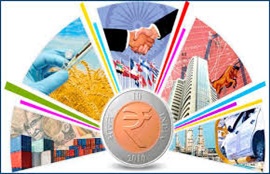India’s GDP growth hits a three-year low of 5.7% in Q1 FY18
01 Sep 2017
India's economy, measured in terms of gross domestic product (GDP), grew 5.7 per cent in the first quarter of the current financial year (April-June 2017-18), its slowest pace since the January-March quarter of 2014, amidst a government crackdown on black money and benami deals that pushed down illegal dealings to the lowest.
 GDP at constant (2011-12) prices in Q1 of 2017-18 is estimated at Rs31,10,000 crore, against Rs29,42,000 crore in Q1 of 2016-17, showing a growth rate of 5.7 per cent, government data showed.
GDP at constant (2011-12) prices in Q1 of 2017-18 is estimated at Rs31,10,000 crore, against Rs29,42,000 crore in Q1 of 2016-17, showing a growth rate of 5.7 per cent, government data showed.
Quarterly GVA (gross value addition) at constant (2011-2012) prices for Q1 of 2017-18 is estimated at Rs29,04,000 crore, against Rs27,51,000 crore in Q1 of 2016-17, showing a growth rate of 5.6 per cent over the corresponding quarter of the previous year.
The economic activities which recorded growth rates of over 7 per cent year-on-year in Q1 of 2017-18 included trade, hotels, transport and communication, services related to broadcasting, public administration, defence and other services, electricity, gas, water supply and other utility services.
Growth rates in activities such as 'agriculture, forestry and fishing', 'mining and quarrying', 'manufacturing', 'construction' and financial, insurance, real estate and professional services are estimated to be 2.3 per cent, (-) 0.7 per cent, 1.2 per cent, 2.0 per cent and 6.4 per cent, respectively, during the period.
The April-June growth rate is much lower than the 6.1 per cent growth recorded in the January-March period, which itself was worse than what economist had forecast.
The Indian economy, which has been dependent on cash, including unaccounted money, to keep growth at a fast pace, lost steam in fiscal first quarter ended 30 June 2017 as growth eluded the parallel economy.
The declining growth will, however, be used by opposition parties as another stick against Prime Minister Narendra Modi's regime. They have already taken up the issue, projecting it as another disruption caused by the demonetisation drive.
GDP at current prices
GDP is derived by adding taxes on products net of subsidies on products to GVA at basic prices.
GDP at current prices in Q1 of 2017-18 is estimated at Rs38,84,000 crore, against Rs35,55,000 crore in Q1 of 2016-17, showing a growth rate of 9.3 per cent. GVA at current basic prices in Q1 of 2017-18 is estimated at Rs35,77,000 crore, against Rs33,17,000 crore in Q1 of 2016-17, showing an increase of 7.9 per cent.
Growth in collection of union excise duties, customs duties and service tax was 7.3 per cent, 15.0 per cent and 20.4 per cent, respectively, in Q1 of 2017-18, against 60.5 per cent, 17.8 per cent and 28.5 per cent, respectively, in Q1 of 2016-17.
Among price indices that are used as deflators, the wholesale price indices (WPI), in respect of the groups such as food articles, minerals, manufactured products, electricity and all commodities, have shown growth rates of (-)1.7 per cent, 5.5 per cent, 2.6 per cent, 0.7 per cent and 2.3 per cent, respectively, year-on-year during Q1 of 2017-18.
The consumer price index (CPI) has shown a rise of 2.2 per cent during Q1 of 2017-18 over Q1 of 2016-17.
The components of expenditure on gross domestic product, namely, consumption expenditure and capital formation, are normally measured at market prices. .
Private final consumption expenditure (PFCE) at current prices is estimated at Rs22,27,000 crore in Q1 of 2017-18 against Rs20,42,000 crore in Q1 of 2016-17. At constant (2011-12) prices, the PFCE is estimated at Rs16,80,000 crore in Q1 of 2017-18 against Rs15,76,000 crore in Q1 of 2016-17.
In terms of GDP, the rates of PFCE at current and constant (2011-2012) prices during Q1 of 2017-18 are estimated at 57.3 per cent and 54.0 per cent, respectively, as against the corresponding rates of 57.4 per cent and 53.6 per cent, respectively, in Q1 of 2016-17.
Government final consumption expenditure (GFCE) at current prices is estimated at Rs5,19,000 crore in Q1 of 2017-18 against Rs4,34,000 crore in Q1 of 2016-17. At constant (2011-2012) prices, the GFCE is estimated at Rs3,91,000 crore in Q1 of 2017-18 against Rs3,34,000 crore in Q1 of 2016-17.
In terms of GDP, the rates of GFCE at current and constant (2011-2012) prices during Q1 of 2017-18 are estimated at 13.4 per cent and 12.6 per cent, respectively, as against the corresponding rates of 12.2 per cent and 11.3 per cent, respectively, in Q1 of 2016-17.
Capital formation
Gross fixed capital formation (GFCF) at current prices is estimated at Rs10,69,000 crore in Q1 of 2017-18 as against Rs10,37,000 crore in Q1 of 2016-17. At constant (2011-2012) prices, the GFCF is estimated at Rs9,28,000 crore in Q1 of 2017-18 against Rs9,13,000 crore in Q1 of 2016-17.
In terms of GDP, the rates of GFCF at current and constant (2011-2012) prices during Q1 of 2017-18 are estimated at 27.5 per cent and 29.8 per cent, respectively, as against the corresponding rates of 29.2 per cent and 31.0 per cent, respectively, in Q1 of 2016-17.
Fiscal deficit hits 92.4% of fiscal year target
The fiscal deficit of the central government stood at Rs5,05,000 crore ($79.01 billion) for the April-July quarter, forming 92.4 per cent of the budget target for the current financial year that ends in March 2018.
The deficit was 73.7 per cent of the full-year target during the same period a year ago.
Net tax receipts in the first four months of 2017-18 financial year were Rs2,58,000 crore as per government estimates.
The government has targeted bringing down the fiscal deficit to 3.2 per cent of gross domestic product in 2017-18 from 3.5 per cent in the previous year.






























